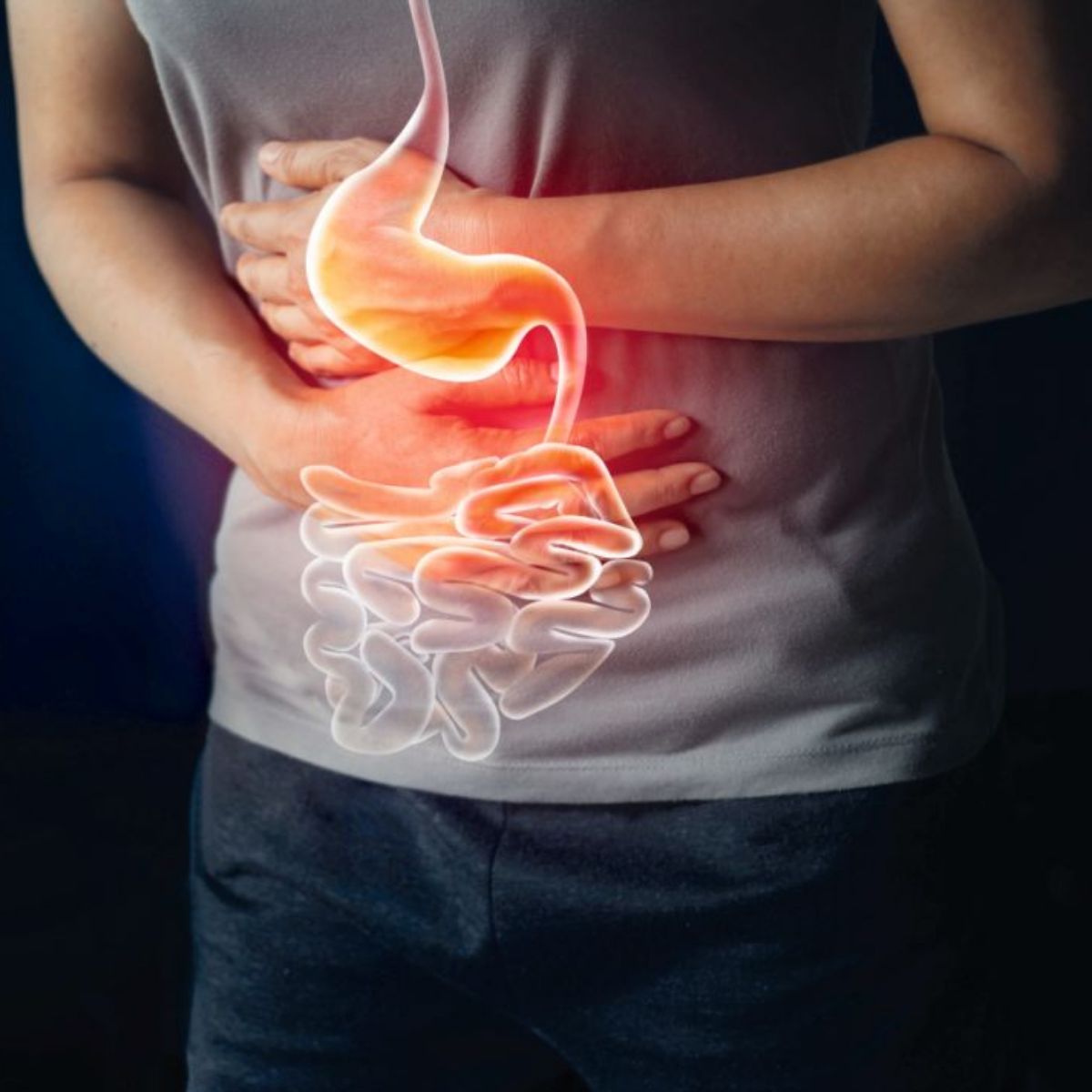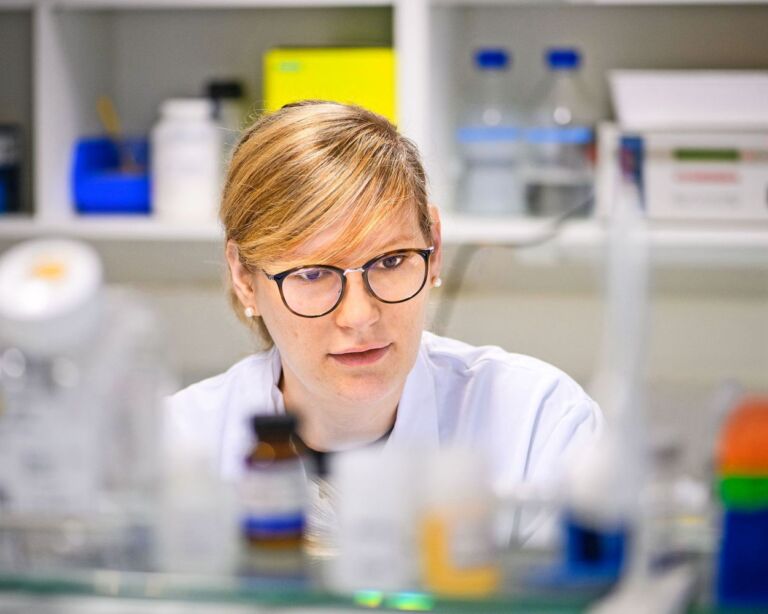Overview: What is stomach cancer?
People with stomach cancer suffer from a malignant tumor in the stomach. This can occur in any part of the stomach. It almost always develops from the glandular tissue of the gastric mucosa. These cells form stomach acid and gastric mucus. Doctors refer to such tumors as adenocarcinomas. In medical terms, stomach cancer is also known as gastric carcinoma.
A malignant tumor at the junction of the stomach and esophagus is referred to as esophageal cancer.
Stomach cancer – early detection is better!
The causes of stomach cancer have not yet been researched in detail, but doctors do know some of the risk factors. The most important cause is an infection with the stomach bacterium Helicobacter pylori. But certain stomach diseases, genes and diet also play a role.
When is stomach cancer no longer curable?
In principle, stomach cancer is curable if the tumor is still small and it is diagnosed early. At this stage, the tumor is often still confined to the stomach, has not yet broken through the stomach wall and has not spread to neighbouring organs. The problem, however, is that stomach cancer often does not initially cause any symptoms that would allow the impending danger in the stomach to be recognized. As a result, many tumors are unfortunately already well advanced at the time of diagnosis. Gastric carcinoma is then often no longer curable, but can be treated. Surgery, chemotherapy, radiotherapy and medication can slow down the progression of the disease, alleviate symptoms and maintain quality of life for as long as possible.
Frequency and age of stomach cancer
In Switzerland, around 890 people are diagnosed with stomach cancer every year. At around 65 percent, men are affected more frequently than women (approx. 35 percent). The risk of stomach cancer increases with age: more than 50 percent of patients are aged 70 or over when doctors diagnose stomach cancer. This type of cancer is therefore rare in young adults.
What types of stomach cancer are there?
Stomach cancer refers to carcinomas that develop in the stomach. There are several types of gastric carcinoma, which are differentiated according to histological criteria. The exact treatment and prognosis depend primarily on the exact stage of the tumor when it is first diagnosed, but also on the individual factors of those affected.
Gastrointestinal stromal tumors (GIST) of the stomach must be distinguished from gastric carcinomas, as they arise from other cells of origin, behave differently from gastric carcinomas (generally less aggressive) and are also treated differently.
Is a stomach carcinoma always malignant?
Gastric carcinomas are always malignant. However, there are also benign tumors that can occur in the stomach, such as gastric polyps. These benign tumors are generally non-invasive and do not spread to surrounding tissue or other organs. However, if they remain untreated or change, they can potentially develop into malignant tumors.
Gastric and esophageal tumor center
At the USZ, numerous specialist departments have joined forces to form a gastric and esophageal tumor center. The center is certified according to the guidelines of the German Cancer Society (DKG). A team of experts specializing in the medical treatment of stomach cancer works closely together here for the benefit of our patients. At DKG-certified centers, patients are treated according to strict quality criteria and, according to current studies, have a better chance of survival on average.
Stomach cancer: causes and risk factors
The origin of stomach cancer is that a cell genetically changes (mutates) and then multiplies uncontrollably. It is not yet known exactly why this is happening. However, some factors are known to increase the risk of developing stomach cancer. These include, for example:
- Infection with the bacterium Helicobacter pylori: It nests in the cells of the stomach lining and triggers inflammation there. A Helicobacter infection is considered the most important risk factor for stomach cancer. The germ is transmitted from person to person, presumably as early as childhood. Helicobacter can be detected in the stomach of many people with stomach cancer. However, the reverse is not true: only very few carriers of the bacterium develop stomach cancer. It is therefore not enough to simply harbor Helicobacter pylori. There must be other factors involved for stomach cancer to develop.
- Diet: A high consumption of cured or smoked meat, sausages and fish, highly salted foods and foods with many preservatives appear to increase the risk of stomach cancer. Those who eat a lot of plant-based foods, on the other hand, reduce their risk.
- Alcohol consumption: High-proof alcohol in particular damages the mucous membranes of the mouth, esophagus and stomach.
- Smoking: Carcinogenic substances dissolve in saliva and enter the stomach when smoking – where they damage the mucous membranes.
- Obesity particularly favors tumors at the junction between the esophagus and stomach.
- Stomach diseases, e.g. chronic gastritis, reflux disease (promotes tumors at the esophagus/stomach junction) or peptic ulcer; the rare autoimmune disease type A gastritis and Ménétrier’s disease (enlarged folds of mucous membrane in the stomach)
- Previous stomach operations, for example due to a stomach ulcer
- Family history: If a relative or first-degree relative (parents, siblings, children) already has stomach cancer.
- Genes: Certain genetic changes increase the risk of stomach cancer, for example familial adenomatous polyposis (FAP) or Peutz-Jeghers syndrome.
- Ionizing radiation: X-rays or gamma radiation
Symptoms: Stomach cancer often goes unnoticed for a long time
Stomach cancer often causes no symptoms for a long time. Sometimes the symptoms are so uncharacteristic that many people classify them as harmless and therefore do not seek medical advice. You are more likely to think of a food intolerance or a sensitive stomach.
The following symptoms can occur with stomach cancer:
- Sudden aversion to certain foods, such as meat
- Sudden intolerance to certain foods, such as fruit, coffee or alcohol
- Loss of appetite
- Difficulty swallowing
- Frequent belching
- Feeling of fullness, pressure in the stomach
- Digestive problems
- Pain in the upper abdomen
- Nausea, nausea and vomiting
- Pain during and after eating
Such complaints can also occur in the context of other illnesses, such as gastric ulcers, irritable stomach syndrome, inflammation of the oesophagus or diseases of the liver, gall bladder and pancreas. Always have the symptoms checked out by a doctor if they are severe, persistent and do not subside.
If stomach cancer progresses further, the following symptoms may occur:
- Unwanted weight loss
- Declining physical performance, feeling of weakness
- Accumulation of water in the abdomen (ascites)
- Black-colored stool (tarry stool) or vomiting of blood – the reason is gastric bleeding
- Enlarged lymph nodes
- Anemia due to the bleeding
Stomach cancer diagnosis
The first step in the diagnosis of stomach cancer is always a consultation in which we ask you a few questions about your medical history (anamnesis). The following points, for example, are of interest to us:
- What complaints do you have exactly and since when?
- How pronounced are the symptoms?
- Are there situations in which the symptoms improve or worsen, for example after eating?
- Do you have a known infection with the Helicobacter pylori bacterium?
- Are you aware of any stomach diseases, such as a stomach ulcer, reflux disease or gastritis?
- Have you already been diagnosed with other illnesses?
- Do you have a family history of stomach cancer or other cancers?
- What is your lifestyle like? Smoking, diet, alcohol consumption?
This is followed by a physical examination during which the doctor palpates the abdomen. This gives them information about the size and position of organs and enables them to detect changes. Although a blood test and the determination of blood values do not provide any clear indications of stomach cancer, they do show how well the organs are working.
Further diagnostic methods for gastric carcinomas
Gastroscopy for the diagnosis of stomach cancer
Gastroscopy is the most important diagnostic tool for stomach cancer. We advance a thin tube with a light source and camera – an endoscope – through the esophagus to the stomach. We see the images from inside on a monitor. At the same time, we can take a tissue sample (biopsy) from suspicious areas as part of the gastroscopy. These are then analyzed under the microscope by a pathologist. Benign and malignantly altered cells can thus be easily distinguished – a pathologist can make a diagnosis of stomach cancer with a high degree of certainty.
During the gastroscopy, you will be given a drug that will put you to sleep so that you are not aware of the examination. It is therefore neither unpleasant nor stressful.
Diagnosis of stomach cancer – these examinations follow
Through further examinations, we find out how large the tumor is, what stage it is in and how far it has already spread.
- Ultrasound (sonography) of the abdomen from the outside: this allows cancer metastases in the liver or lymph nodes to be detected.
- Ultrasound of the stomach from the inside (endoscopic ultrasound): A thin, flexible instrument is used in the same way as for gastroscopy. It is pushed into the stomach via the esophagus. Instead of the camera, the instrument is equipped with an ultrasound probe. This allows us to determine how deep the tumor has penetrated into the stomach wall.
- Computed tomography (CT): This method works with X-rays and images the body slice by slice. For example, we can use the cross-sectional images to detect metastases in the lymph nodes and other organs.
- Magnetic resonance imaging (MRI = magnetic resonance imaging): Radiologists use strong magnetic fields in MRI and also obtain cross-sectional images of the body. This method is used if CT is not possible or the findings are still unclear.
- Positron emission tomography/CT (PET/CT): PET/CT shows particularly metabolically active areas, for example metastases. We usually use the radioactively labeled sugar “18F-FDG” as the radioactive substance.
- An X-ray examination of the lungs and abdomen shows whether the stomach cancer has spread there.
- Sometimes laparoscopy, if other examinations have not provided meaningful results on the spread of the tumor. You will have to stay in hospital for a short time.
Staging – the spread of stomach cancer
We then determine the stage of the stomach cancer (staging), which also determines the treatment and prognosis. The so-called TNM classification is used internationally. These letters stand for the following:
- T = Tumor size: There are different stages of tumor size (superficial carcinoma in situ): The classifications range from T1 to T4. The higher the number after the letter, the larger the tumor and the deeper it has penetrated into the layers of the stomach wall and into neighboring organs (e.g. intestine, liver, spleen, pancreas).
- N = English Nodes (lymph nodes): Have cancer cells migrated into the lymph nodes? N0 means that no neighboring lymph nodes are affected, N1 stands for one to two lymph nodes, N2 for three to six lymph nodes and N3 for 7 to 15 (N3a) or even more affected lymph nodes (N3b).
- M = Metastases: Are distant metastases detectable in other organs? M0 means that there are no cancer metastases in other organs, M1 stands for the presence of distant metastases.
During grading, pathologists use cell samples to determine how aggressive the tumor is. They compare how similar they are to healthy tissue. Grading ranges from G1 (still very similar) to G4 (no longer similar). The lower the level, the less aggressive the tumor.
We also use the so-called Laurén classification for stomach cancer, which in turn is important for planning the operation and the prognosis. We take a close look at the growth behavior and appearance of the stomach cancer under the microscope. There are two main types:
- Intestinal type: The cancer grows into the stomach in a mushroom shape, is well limited and has a slightly better prognosis. Around 50 percent of all stomach cancer sufferers have this type.
- Diffuse type: The cancer spreads in the stomach wall, is poorly defined and the prognosis is less favorable. This type is found in around 40 percent of those affected.
There are also hybrid forms between the two types.
Second opinion for stomach cancer
When a cancer diagnosis is made, a second medical opinion is an important decision-making tool. The Comprehensive Cancer Center Zurich supports you with a professional expert opinion. They receive a thorough analysis of the situation as well as personal advice and quick answers to their questions.
Stomach cancer: prevention and early detection
You cannot prevent stomach cancer with absolute certainty. But you can reduce risk factors. A healthy lifestyle reduces the risk of stomach cancer: This includes:
- A balanced diet with lots of plant-based foods: Fruit, vegetables, whole grain products, legumes, vegetable oils
- Little meat, smoked, cured and grilled food
- Consume alcohol sparingly, special care should be taken with high-proof drinks
- No smoking
- Normal body weight
- Lots of movement
There is no recommended early detection for stomach cancer as there is for breast cancer or bowel cancer. Visit your doctor in good time if you experience any symptoms. They may not be able to prevent stomach cancer, but they may be able to prevent worse. This is because the earlier we diagnose stomach cancer, the gentler the treatment and the better the chances of recovery.
You should also go for medical check-ups if you already have a stomach disease or other illness that increases the risk of stomach cancer. Check-ups are also important if you have a family history of stomach cancer or have had stomach surgery in the past.
Course and prognosis of stomach cancer
As with almost all cancers, the following also applies to stomach cancer: if it is detected early, it is usually still small and the course and prognosis are more favorable. However, doctors often only diagnose it at a late stage due to the lack of or characteristic symptoms. By then, stomach cancer has already spread to the lymph nodes and other organs via the blood and lymph channels – it is then usually considered incurable. Sometimes metastases are found in the liver, lungs or peritoneum. However, doctors can often stop the progression, alleviate the symptoms and maintain a good quality of life.
In the case of stomach cancer, regular follow-up care is important after the initial treatments have been completed. We monitor your physical and mental state of health, alleviate discomfort and the side effects of medication and try to detect any relapse as quickly as possible. Initially, shorter check-up intervals every three months are recommended. After that, the time intervals become longer and longer. Rehabilitation is also an important part of cancer treatment.
You will receive nutritional advice, various exercise therapies, oncological physiotherapy, occupational therapy and psycho-oncological support. Rehabilitation strengthens your body and soul and you will then be able to cope better with your cancer in everyday life.
Nursing consultations and supportive counseling and treatment services
Stomach cancer: treatment with different strategies
Which treatments are suitable for stomach cancer depends on the aggressiveness and spread of the tumor, your age, state of health and your personal wishes. We usually combine different therapies to increase their effectiveness. Sometimes the stomach cancer is already more advanced and a cure is no longer possible. But treatment can alleviate the symptoms, slow down the progression and maintain a good quality of life. There is also the possibility of accompanying complementary medical treatment.


